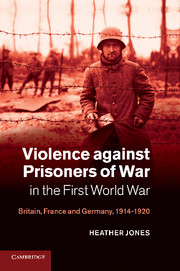Book contents
- Frontmatter
- Contents
- List of illustrations
- List of tables
- Acknowledgements
- Abbreviations
- Introduction
- Part I Propaganda representations of violence against prisoners
- Part II Violence and prisoner of war forced labour
- Part III The end of violence? Repatriation and remembrance
- Glossary of foreign terms
- Bibliography
- Index
Part III - The end of violence? Repatriation and remembrance
Published online by Cambridge University Press: 05 January 2014
- Frontmatter
- Contents
- List of illustrations
- List of tables
- Acknowledgements
- Abbreviations
- Introduction
- Part I Propaganda representations of violence against prisoners
- Part II Violence and prisoner of war forced labour
- Part III The end of violence? Repatriation and remembrance
- Glossary of foreign terms
- Bibliography
- Index
Summary
Introduction to part III
By November 1918, there had been radical changes in how the prisoner of war was represented and how prisoners of war were treated. Violence against prisoners had evolved during the conflict to reach a point, in 1918, where it had become a significant military problem: it had reached irrational levels in the German army and was spiralling out of control. The primary function of an army is to implement violence in a disciplined way – but violent practices against prisoners had now come full circle, actually undermining obedience to orders in the German case, as harassed guards, faced with impossible labour demands, beat prisoners to force more work out of them. Labour was vital to armies by 1918 – the radicalisation of violent practices against prisoner workers in the German army was counterproductive and inefficient.
Given this scenario there was no longer any meaningful attempt to refer to pre-war international law, which had accorded the prisoner of war legal protections and cultural non-combatant status. The only laws which still retained any validity were the agreements made between belligerents on the basis of reciprocity at The Hague and Berne in 1917 and 1918. However, these were far from satisfactory. Large parts of these agreements had still not been implemented by the end of the war, and those aspects which had come into force – such as the thirty-kilometre rule – had not been uniformly kept.
- Type
- Chapter
- Information
- Violence against Prisoners of War in the First World WarBritain, France and Germany, 1914–1920, pp. 253 - 256Publisher: Cambridge University PressPrint publication year: 2011

